 Twelfth-century Frankish royalty
Twelfth-century Frankish royalty. The Frankish prince wears a long, elaborately embroidered bliaud with extremely long sleeves, perhaps to keep his hands warm. His chainse is floor length. Tied at the shoulder, his mantle has an embroidered band at the bottom. The princess wears an outfit with finely embroidered trim. Circling her long bliaud is a double girdle of jeweled leather with silk ties.
 Eleventh-century peasants
Eleventh-century peasants. Under her cloak, the woman wears a bliaud covered with an apron laced for fit. She wears cross-gartered, soft leather stockings, On her head is a headrail. The man wears a short tunic over looser drawers which are cross-gartered. His cloak is tied at the shoulder. On his head he wears a peaked cloth or a Phrygian helmet-shaped cap. His shoes are leather.
 Twelfth-century merchant and noblewoman
Twelfth-century merchant and noblewoman. The commoner merchant wears a belted surcoat over a bliaud. His mantle fastens at the shoulder; a pouch hangs from the belt or girdle. On his head is a conical felt hat. The woman wears a short-sleeved bliaud over a full-sleeved chemise, and a long mantle over all. The mantle and bliaud are edged with jeweled embroidery. Her headgear includes a conical hennin, or high headress, over her headrail, or veil.
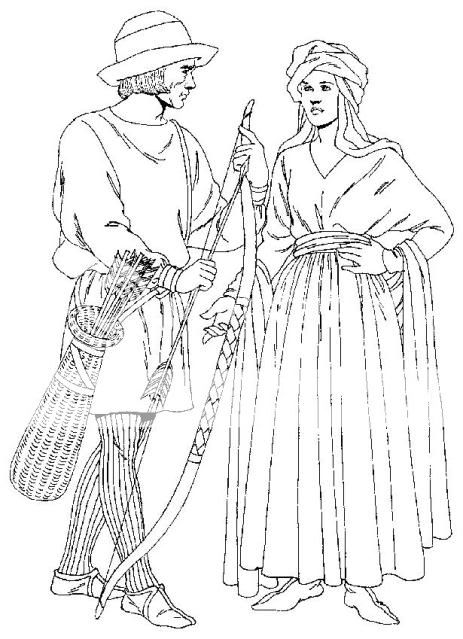 Twelfth-century French commoners
Twelfth-century French commoners. The hunter wears a short tunic with batwing or dolman sleeves. Bloused fabric at his waist covers a belt. He wears knitted stockings, low cut leather shoes, and a felt hat. A wicker quiver hangs from his waist and he holds a long bow. Carrying a shoulder scarf or a stole, the townswoman wears a belted bliaud with dolman sleeves. Her headrail is wrapped like a turban.
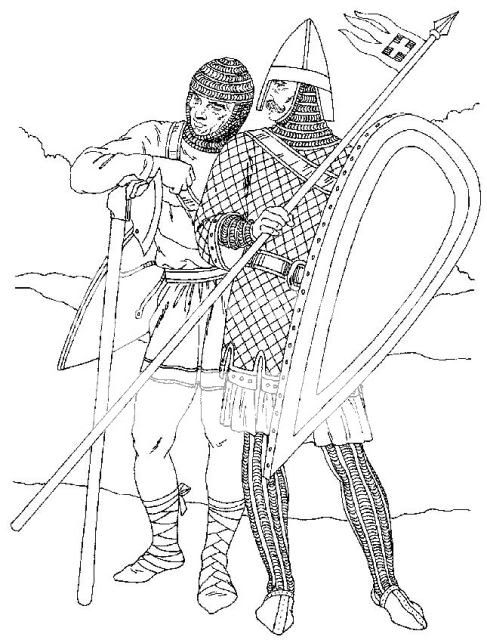 Eleventh-century soldier and knight
Eleventh-century soldier and knight. Left, the foot soldier wears a short tunic, cross-gartered tights, and leather shoes. A chain-mail hood covers his iron skullcap. Over his chest he wears a leather baldric, a diagonal sash for carrying a shield and knife; he holds a battle-ax. Right, the crusader knight is wearing a metal battle helmet, or spangenhelm, over a chain-mail hood. He wears a soft under-tunic or pourpoint covered by his tunic of hardened leather tiles. His arms and legs are protected by fitted chain-mail sleeves and leggings; his shoes are leather.
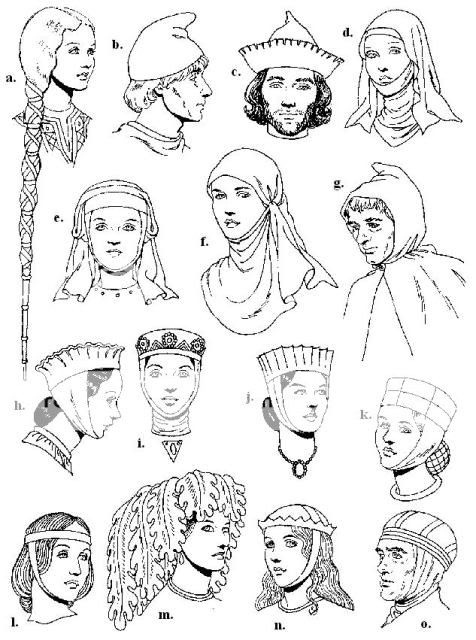 Twelfth-century headdresses
Twelfth-century headdresses.
a. Long plaids bound with ribbons with metal cylinders covering the ends.
b. Phrygian or close-fitting cloth cap.
c. A peaked hat made of felt with castellated brim.
d. Linen gorget, or collar.
e. Folded wimple worn over chin strap cap.
f. Wimple.
g. Hood and cape.
h. White linen toque with pie-crust edging worn over chin band.
i. Jeweled velvet toque worn over gorget and chin-band.
j. Chin-band and toque of pleated linen.
k. Toque worn over a chin-strap cap with net caul covering hair.
l. Chin-band and headband of ribbon.
m. Turban with moiré leaves.
n. While linen cap and chin-band under a gold crown,
o. Men's version of the wimple with banded wool cap.
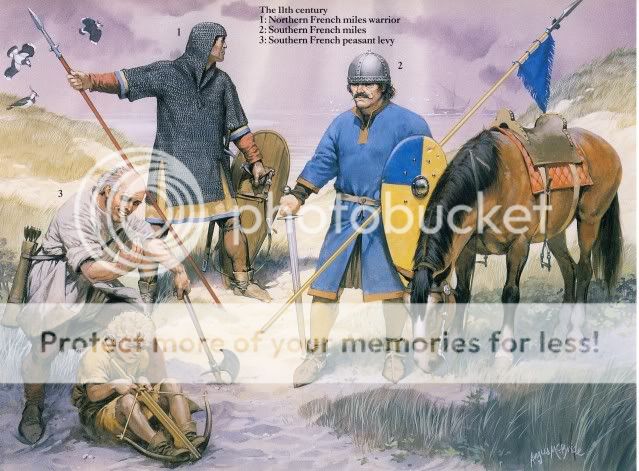 Northern French miles warrior
Northern French miles warrior. There was a lot of uniformity in the arms of Western Europeans cavalry in the 11th century. This man has an early form of mail
hauberk slit at the sides. The
ventail to protect his face is shown unlaced, while his thrust through a slit in the
hauberk into a scabbard and belt worn beneath. His shield is of the large so-called "Norman" type.
Southern French miles. This warrior has a one-piece helmet on which the metal strips are merely decorative, but lacks body armor.
Southern French peasant levy. Here a southern peasant watches his son span an early form of hunting crossbow in a way shown in the earliest illustrations. He is also armed with a massive war-axe.
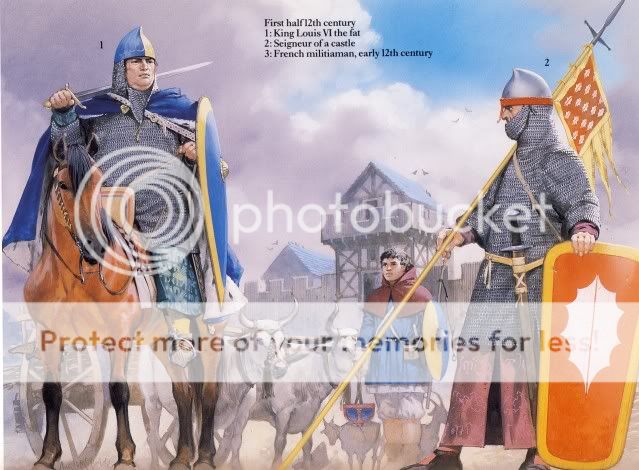 King Louis VI The Fat
King Louis VI The Fat. In the first half of the 12th century arms and armor differed only in detail from those seen earlier. The sleeves of the mail
hauberks grew longer, while a forward-curved one-piece helmet became widespread; its shape probably indicated that front was thicker than the sides and the rear. War-saddles were now of the fully developed peaked type.
Seigneur of a castle. The main features distinguishing this knight are his large rectangular shield for infantry combat, a simpler helmet with a large nasal fastened to its brow-band , and the sword-belt being worn outside his
hauberk. The device on his shield is that traditionally given to the lords of Chalo.
French militiaman, early 12th century. This man has a very simple equipment, except for his framed iron helmet. He has a knife and buckler shield for close combat but carries a substantial staff-sling, perhaps to hurl rocks at the defenders of a castle.
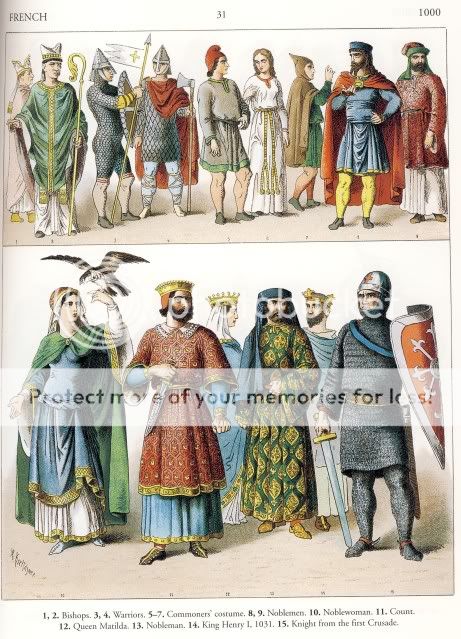
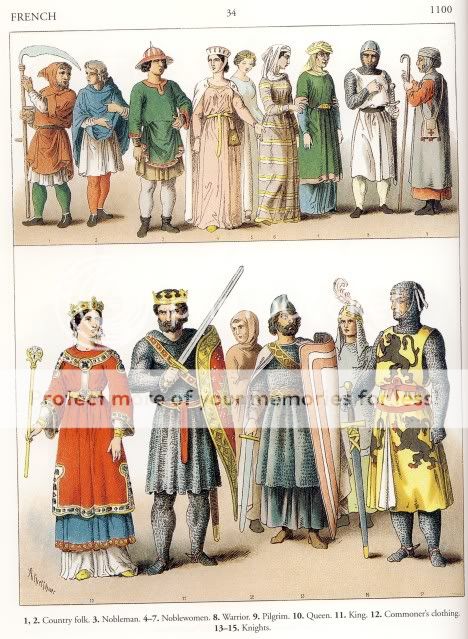
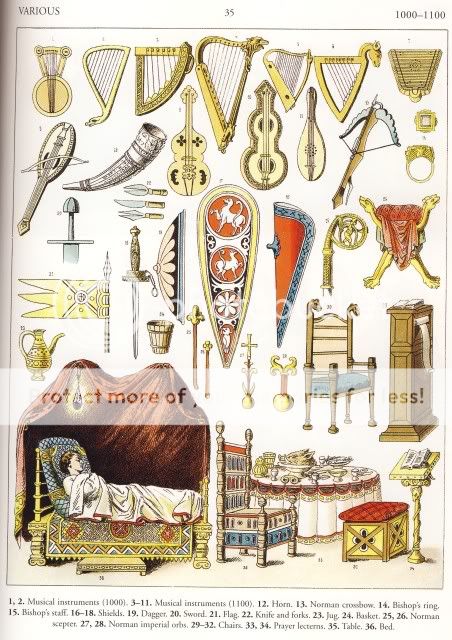















 Reply With Quote
Reply With Quote
Bookmarks